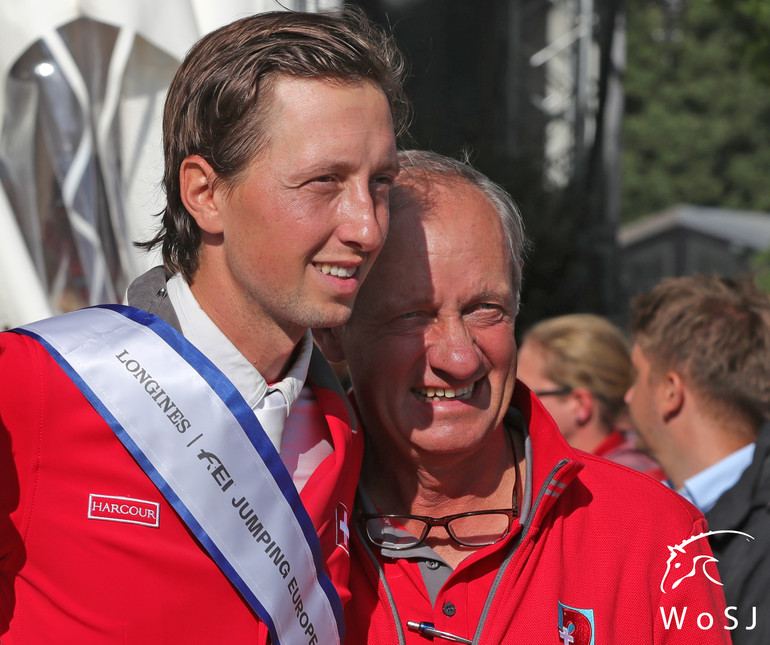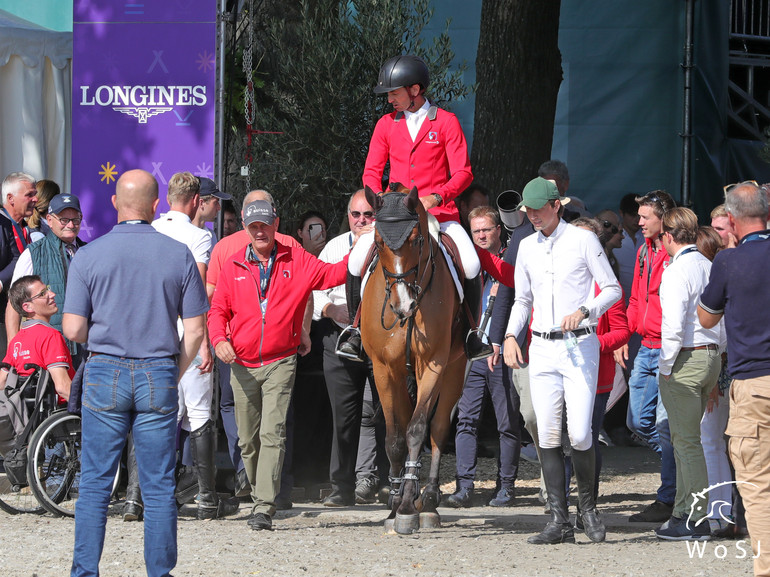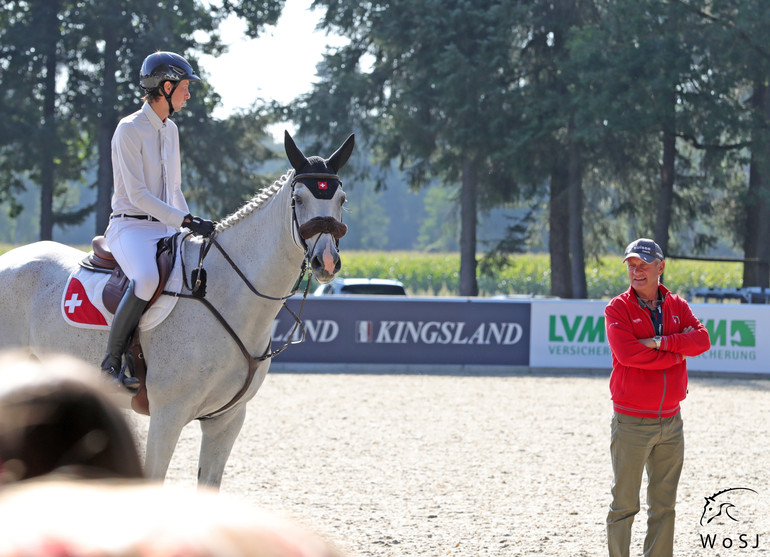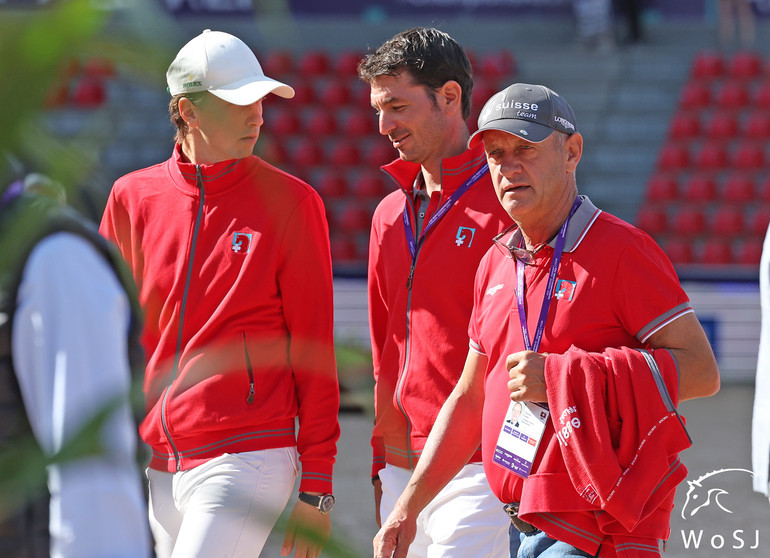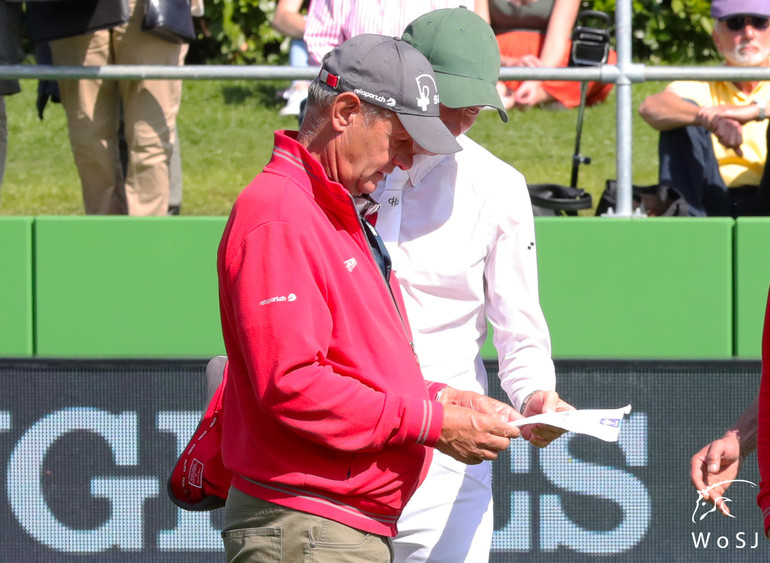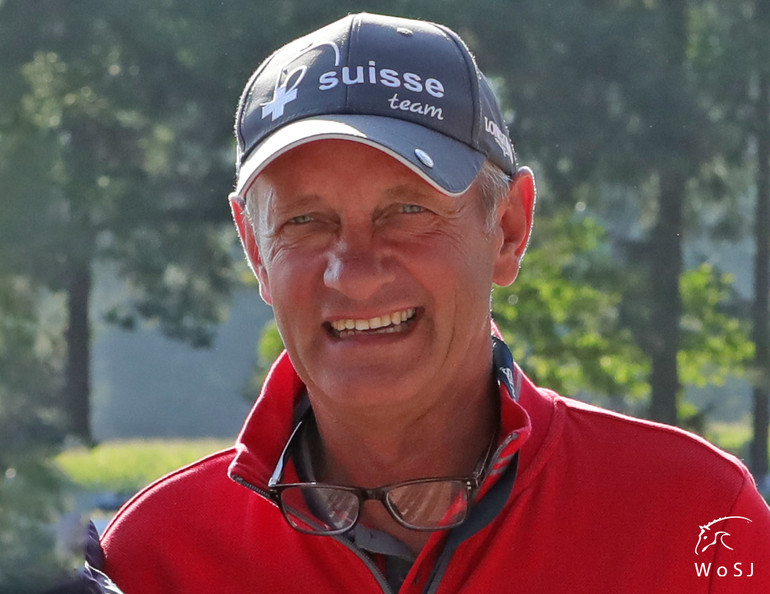Text © World of Showjumping
Steve Guerdat has referred to him as “one of the best – if not the best horseman in the world”. Martin Fuchs has said he is “one of the best in the business”. He’s greatly admired by the world’s top riders, and one of the most sought-after trainers in the sport. Thomas Fuchs is the man behind the Swiss success and has nurtured one talent after the other, bringing rider after rider to the very highest level of the sport – the latest being 23-year-old rising star Edouard Schmitz, who was selected to represent Switzerland at the FEI Jumping World Championship in Herning, Denmark, alongside Steve Guerdat, Martin Fuchs and Pius Schwizer. Like both Martin and Steve, Edouard has credited Thomas Fuchs for his success – saying it’s been invaluable to have the renowned trainer show him the way.
World of Showjumping sat down with Thomas Fuchs, and asked him to share his thoughts and opinions on good horsemanship and ideal horse management.
“I think good horsemanship is to ensure that the horses have the best life possible, and that they live as natural as they can,” Fuchs says. “For me, that means that the horses are out a lot and not 23 hours in the box. Furthermore, good horsemanship also has to do with care, feeding and exercising – there are a lot of elements that go into practicing good horsemanship.”
“We take the horses out as much as possible,” Fuchs says about his own system. “They go out on the walker, but not long – I get mad if they are on for more than half-an-hour. Just walking around on a circle is perhaps ok for people who are too lazy to ride, but we prefer to take the horses for hacks before or after they work. Our horses have to work though; not hard, but long,” Fuchs says. “They are for sure exercised more than an hour a day. Although we don’t work them one hour strong, they go for a walk, then they are worked a bit on the flat – for 30 minutes or so – and then later they go for a hack with one of the grooms. The variation is extremely important for the horses in my opinion. Do various things with them; I think that makes the horses interested in the work.”
The variation is extremely important for the horses
“Next to doing a session of flat work, our horses usually go 45 minutes for a hack, as well as some hill climbing. When we hack them out, we also trot them a bit on a hard surface, as well as on uneven surface, as the horses need a lot of different surface to move on. I’m not completely against these super-sand surfaces, but it’s always straight, and no ups or downs, so when the horses have to show in grass rings that are not completely even, they get lost if they are only exercised on artificial sand surfaces.”
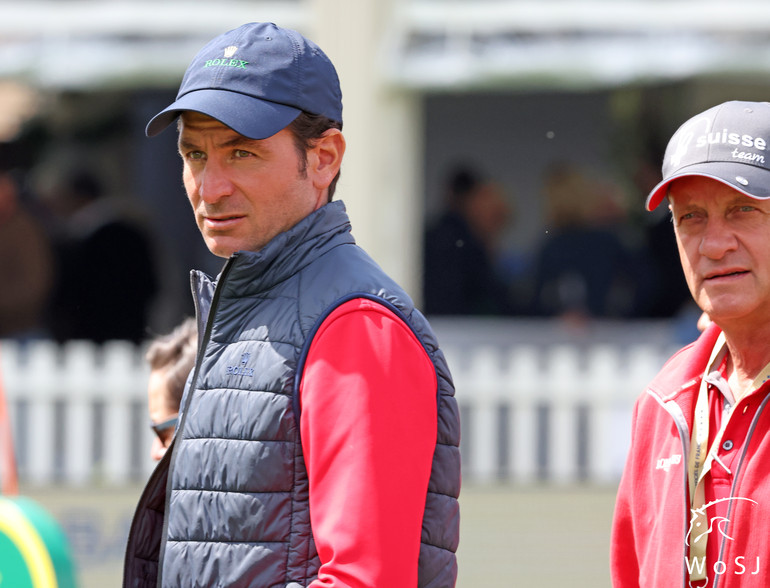 "A lot is going around the main guy, who is Thomas Fuchs – he is the guy who has been pushing the team forwards for many years. Not just because he is Martin's dad, but because he is probably one of the best – if not the best horseman in the world. He has probably played the biggest part in what I became as a rider, and now with Martin. I think it is amazing to have him on our team," Steve Guerdat has said. Photo © Jenny Abrahamsson for World of Showjumping.
"A lot is going around the main guy, who is Thomas Fuchs – he is the guy who has been pushing the team forwards for many years. Not just because he is Martin's dad, but because he is probably one of the best – if not the best horseman in the world. He has probably played the biggest part in what I became as a rider, and now with Martin. I think it is amazing to have him on our team," Steve Guerdat has said. Photo © Jenny Abrahamsson for World of Showjumping.
“When we take the horses hacking, it’s not just to play though,” Fuchs says. “Sometimes we are 6-8 horses on the road with traffic around, so I like to have order. We ride beside each other in a certain way; in a formation, stirrup to stirrup, not one horse five meters in front or behind, but together, and all the horses need to learn to walk both in front, or behind, in the group. It’s a little bit of discipline; it’s not just playing around. I think riding the horses in a group this way really can help them, especially if they are a bit horse-shy, it can really improve them in the warm-up. It will not change the career of a horse, but it can improve them. For the rider, it’s of course possible to enjoy the hack, but you also have to concentrate when you go out like that – you have to think about the horse all the time. I also think climbing up a steep hill is better than to make thirty jumps at 1.40m, the horse gets more muscle and strength from that than from lots of jumping. On top, I think the horses really like it. Sometimes, I have had people say ‘But, we cannot go with Clooney down this hill’, and my reply is always ‘Why not?’ – our horses, they do everything.”
You have to make sure the horses enjoy what they do
“We also have our horses out a lot in the field and paddocks,” Fuchs says. “And we turn out all our horses without protection, without boots, bandages, or overreach boots, there is very seldom an exception to this – unless they have a very special need for it. Look at Clooney for example, we could have wrapped him in with whatever, but he would anyway have broken his shoulder.”
“You have to make sure the horses enjoy what they do. You need the horse to want to help you, because there are situations in the ring where you will need that. Hence, I prefer a horse that enjoys its life and is mentally on top of its game rather than ridden to perfection on the flat,” Fuchs points out.
“Probably I am not as good a trainer as people think. It’s just easier when you train the two best riders in a country, then perhaps a third or fourth – people just start listening more to what you say,” Fuchs laughs. “I do think we have a very good relation to the horse though,” Fuchs says about his system. “We are strong enough with our flatwork, but we don’t exaggerate – we have a natural way. I remember in the beginning, when I took Steve out to gallop on the grass, up and down the hills, he said ‘you are completely crazy to do this with the good horses’, but now he does it all the time and jumps the natural fences with all his horses. And I think the horses really like this kind of training.”
“I also think we do a lot less jumping with the horses than most people do,” Fuchs continues. “Instead, we make a lot of gymnastics in our dressage work, to make the horses supple – which also makes it possible to jump them less. Ahead of a big class, we very seldom do much more than ten jumps – including the smaller ones. It’s not jumping, jumping, jumping – I don’t think the horses need it, so we jump a lot less than most.”
We have a natural way
“Once, Clooney had a break of six weeks and he did not jump once during that time. However, he still had the gymnastic elements in his training from going up and down the hills, over the steps to the bank and down,” Fuchs explains. “Then he went to Doha and was second in the Grand Prix. The last four years of his career, I don’t think Clooney did more than thirty jumps that were 1.30 or higher – we don’t really jump a lot big. Maybe when they are 7-8, but with the older horses we do much more gymnastics than jumping.”
“To reach the top, you have to be a horseman and understand the horses. You have to know – you have to feel how the horse feels, and you have to make the horse work for you,” Fuchs says. “The horses have to like to do it for you, and that’s why I say they need variation because they get bored if they do the same every single day.”
“I don’t think riders that don’t feel the horses can succeed. And the feeling is probably the most difficult thing to learn,” Fuchs says. “In the past, it perhaps came more natural – it was usually the army that was responsible for teaching horsemanship. My father grew up on a farm, and then got further knowledge in the army – so it came to him this way, and he passed it on. These days, a lot of people don’t even learn how to ride before they go to their first show so for sure it’s difficult for them to learn real horsemanship.”
The horses have to like to do it for you
“We can also learn a lot from each other, and just by watching,” Fuchs says. “And the ones who really want to learn, they watch – and they even learn from those who ride bad, because they see how not to do it. That’s why I think that usually, you can forget about ¾ of the riders on a junior team. Out of four, one takes the time watching the others – and that’s the one that will go on and become good."
“I’m not such a good guy when I train,” Fuchs says with a grin. “Let’s say when Martin started, I’m quite sure that if I was the one always going with him to the shows, he would not ride any more. I always thought he would never learn how to ride when he was 12-13. I left the show more than once… But my wife Renata still believed, so she took over – luckily. Years ago, at the youth Europeans in Comporta, a guy came over to me and said: ‘Many years ago I came to train with you for a few months, and I took your advice: ‘You better stop riding, you’ll never learn it’ – that was not the nicest thing I had said...,” Fuchs laughs. “Nowadays I only teach a few riders, and I normally only take on the really talented ones to try help them improve.”
The ones who really want to learn, they watch
“In the end it has to come automatic to you; it’s seven a bit long, eight a bit short, but the riders have to know that when they arrive on a forward distance on the line before that the distance after will be like this or that – you can’t explain this every single time,” Fuchs says. “And I think you have to train riders so they can go to a show on their own without messing up. You should not make them so dependent on you that they can’t go out and do it on their own. When I walk the course, I don’t talk a lot, I don’t take my riders through it step by step. Once, I walked the course next to another trainer, and after I said: ‘If I had to remember everything what you told that girl now, I could not ride the course at all’,” he chuckles.
“These days, Martin does not really need me anymore. He and Steve help each other, they have the same approach – I don’t really worry about them,” Fuchs smiles. “I think they have learned a lot from each other; and they still do. Martin also always picks up new ideas, especially when he is in the US – but if I’m honest, I very seldom like them,” Fuchs laughs.
“I think these days, there are so many more good riders than there were in the past,” Fuchs says. “Most riders have a good technique, and the horses are very well trained – it’s a lot more pleasant to watch than before, with less bad pictures. The sport has evolved a lot over the last forty years. I remember in 1979, when I went with a Swiss team for the fall circuit in the US for the first time, and we were first introduced to walking distances. At this time, we would never walk a distance in Europe – and it’s not that long ago. Then at the end of 79, I organized a training with George Morris in Europe and from there on, the Swiss started to walk the distances. The rest of Europe were all laughing at us, it was only Belgium’s Jean Claude Van Geenberghe and us Swiss that did this back then. Then in 1981 we finished second at the Europeans in Munich, previously we had always done really bad, and then everybody started walking the distances. Today, we walk distances around the turns for a jump-off,” he grins.
The more you know, the more you understand that you don’t know
“The ultimate horseman? After me, you mean?” Fuchs laughs when asked who he admires the most. “It always depends a little bit, Fredy Knie Jr – from the Circus Knie – a real horseperson, and a great dressage trainer. George Morris was a fantastic trainer too, and Paul Weier from Switzerland for sure a horseman through and through – Swiss Champion in dressage, eventing and jumping. In my opinion, you should not just have one favourite though – you should learn from many and that makes the difference – learn dressage from one, gymnastics from another, jumping from someone else. I think the one who learns from different systems, becomes the most complete horseman.”
“I also went to school once you know,” Fuchs smiles, “and back then, I had a teacher who said that the more you know, the more you understand that you don’t know. In our sport, you never stop learning.”
9.9.2022 No reproduction of any of the content in this article will be accepted without a written permission, all rights reserved © World of Showjumping.com. If copyright violations occur, a penalty fee will apply.



